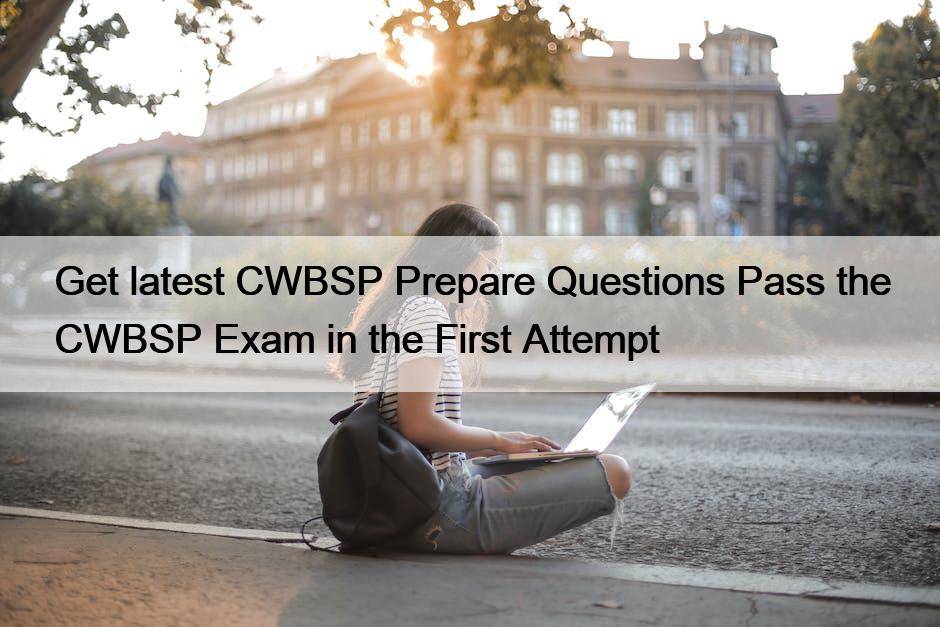Most Popular
 Free PDF Quiz Secure-Software-Design - Reliable WGUSecure Software Design (KEO1) Exam Study Test
Free PDF Quiz Secure-Software-Design - Reliable WGUSecure Software Design (KEO1) Exam Study Test
Real Secure-Software-Design questions in our PDF document can be viewed ...
 Download The Open Group OGBA-101 Pdf & Clearer OGBA-101 Explanation
Download The Open Group OGBA-101 Pdf & Clearer OGBA-101 Explanation
Did you often feel helpless and confused during the preparation ...
 C-THR81-2311 Exam Materials and C-THR81-2311 Test Braindumps - C-THR81-2311 Dumps Torrent - PDFTorrent
C-THR81-2311 Exam Materials and C-THR81-2311 Test Braindumps - C-THR81-2311 Dumps Torrent - PDFTorrent
The software version is one of the different versions that ...



Get latest CWBSP Prepare Questions Pass the CWBSP Exam in the First Attempt

PassLeader is famous for our company made these CWBSP Exam Questions with accountability. We understand you can have more chances getting higher salary or acceptance instead of preparing for the CWBSP exam. Our CWBSP practice materials are made by our responsible company which means you can gain many other benefits as well. We are reliable and trustable in this career for more than ten years. So we have advandages not only on the content but also on the displays.
NFPA CWBSP Exam Syllabus Topics:
| Topic | Details |
|---|---|
| Topic 1 |
|
| Topic 2 |
|
| Topic 3 |
|
| Topic 4 |
|
>> Reliable CWBSP Exam Voucher <<
CWBSP Reliable Test Vce - CWBSP Exam Testking
CWBSP learning materials can help them turn to very clear ones. We have been abiding the intention of providing the most convenient services for you all the time on Certified Water-Based Systems Professionals CWBSP Study Guide, which is also the objection of us. NFPA CWBSP practice materials are successful measures and methods to adopt.
NFPA Certified Water-Based Systems Professionals Sample Questions (Q52-Q57):
NEW QUESTION # 52
In an existing system, the vertical clearance between a high volume low speed (HVLS) fan and a sprinkler shall be
- A. 36 in. (900 mm).
- B. 24 in. (600 mm).
- C. 48 in. (1200 mm).
- D. 12 in. (300 mm).
Answer: B
Explanation:
NFPA 13 requires a minimum vertical clearance between HVLS fans and sprinklers to prevent interference with the sprinkler spray pattern. A 24 in. (600 mm) clearance is commonly recommended to ensure that the fan does not disrupt the distribution of water in the event of a fire.
References: NFPA 13 guidelines regarding the installation of sprinkler systems in areas with HVLS fans to ensure effective fire protection coverage.
NEW QUESTION # 53
A fire pump must produce at least what percentage of its rated pressure at the 150% flow condition?
- A. 50%
- B. 120%
- C. 100%
- D. 65%
Answer: D
Explanation:
A fire pump must produce at least 65% of its rated pressure at the 150% flow condition. This requirement ensures that the pump can still maintain a significant portion of its pressure even when operating beyond its rated capacity, providing a margin of safety.
References: NFPA 20 sets the standards for the installation of stationary pumps for fire protection, including performance requirements at various flow conditions.
NEW QUESTION # 54
If a jockey pump start point is set at 165 psi (11.4 bar), the jockey pump stop point should be not less than
- A. 130 psi (8.96 bar).
- B. 175 psi (12.06 bar).
- C. 188 psi (12.96 bar).
- D. 153 psi (10.55 bar).
Answer: B
Explanation:
The jockey pump stop point is typically set slightly above the fire pump start point to prevent unnecessary cycling of the fire pump. If the jockey pump start point is at 165 psi, the stop point should be higher to maintain system pressure and prevent overlap with the fire pump activation threshold, making 175 psi a suitable stop point.
References: NFPA 20 and CWBSP materials, which cover the installation and testing of fire pumps, including jockey pumps, recommend setting the jockey pump's stop pressure above its start pressure to ensure seamless system pressure maintenance.
NEW QUESTION # 55
Where must a diesel engine driven fire pump's fuel tank be located for areas subject to temperatures below 32° F (0°#)?
- A. The room below the fire pump.
- B. The room next to the fire pump room.
- C. The same room as the fire pump.
- D. The exterior of the building.
Answer: C
Explanation:
The fuel tank for a diesel engine-driven fire pump must be located in the same room as the fire pump, especially in areas subject to freezing temperatures, to ensure that the diesel fuel remains at a usable temperature and the pump is readily available for operation during an emergency.
References: NFPA 20 provides the standards for the installation of stationary pumps for fire protection, including the requirements for diesel engine-driven pumps and their fuel supply.
NEW QUESTION # 56
The owner's information certificate shall contain which of the following?
- A. The specific area/density for the building
- B. The specific storage classification
- C. Any special knowledge of the water supply
- D. Total occupant load of the proposed building
Answer: C
Explanation:
The owner's information certificate should contain any special knowledge of the water supply. This information is crucial for understanding the capabilities and limitations of the water supply serving the fire protection system.
References: NFPA 13 requires the provision of comprehensive information about the building and its fire protection systems, including details about the water supply.
NEW QUESTION # 57
......
With the help of our NFPA CWBSP practice materials, you can successfully pass the actual exam with might redoubled. Our company owns the most popular reputation in this field by providing not only the best ever NFPA CWBSP Study Guide but also the most efficient customers' servers.
CWBSP Reliable Test Vce: https://www.passleader.top/NFPA/CWBSP-exam-braindumps.html
- PDF CWBSP Cram Exam 👴 CWBSP Formal Test 🐘 CWBSP Online Lab Simulation 🚛 Download ⏩ CWBSP ⏪ for free by simply searching on ( www.real4dumps.com ) ↕CWBSP Valid Test Camp
- Free PDF Quiz NFPA - Perfect Reliable CWBSP Exam Voucher 🐼 Download ✔ CWBSP ️✔️ for free by simply entering ( www.pdfvce.com ) website 🕯CWBSP Reliable Exam Simulations
- Free PDF 2025 NFPA CWBSP: Certified Water-Based Systems Professionals Pass-Sure Reliable Exam Voucher ⏬ Download ➥ CWBSP 🡄 for free by simply entering { www.real4dumps.com } website 🌭CWBSP Brain Exam
- 2025 Newest 100% Free CWBSP – 100% Free Reliable Exam Voucher | CWBSP Reliable Test Vce 🧰 Go to website 【 www.pdfvce.com 】 open and search for ( CWBSP ) to download for free 💉Free CWBSP Practice Exams
- NFPA CWBSP Web-Based Practice Test ▶ Download ⇛ CWBSP ⇚ for free by simply entering [ www.free4dump.com ] website 🐓CWBSP Guaranteed Success
- CWBSP Exam Papers 🗜 CWBSP Latest Training 🌵 PDF CWBSP Cram Exam 📡 Search for ▛ CWBSP ▟ on 【 www.pdfvce.com 】 immediately to obtain a free download 🦧CWBSP Brain Exam
- 2025 Newest 100% Free CWBSP – 100% Free Reliable Exam Voucher | CWBSP Reliable Test Vce 🍴 Search for ☀ CWBSP ️☀️ and download it for free immediately on 【 www.exam4pdf.com 】 🏪CWBSP Brain Exam
- Avoid Failure in Exam By Using NFPA CWBSP Questions 😶 Enter ▛ www.pdfvce.com ▟ and search for ✔ CWBSP ️✔️ to download for free ⌚Reliable CWBSP Exam Practice
- Valid CWBSP Cram Materials 🆘 CWBSP Exam Papers 🌤 CWBSP Guaranteed Success 😾 Copy URL 【 www.prep4away.com 】 open and search for [ CWBSP ] to download for free 🦠CWBSP Valid Test Camp
- CWBSP Valid Test Review ⚜ Reliable CWBSP Exam Preparation 🥊 CWBSP Lead2pass 🧳 Go to website { www.pdfvce.com } open and search for [ CWBSP ] to download for free 🎴Latest CWBSP Test Online
- Latest Certified Water-Based Systems Professionals free dumps - CWBSP passleader braindumps 🦟 Easily obtain free download of ⮆ CWBSP ⮄ by searching on { www.prep4away.com } ⛳Dump CWBSP Check
- CWBSP Exam Questions
- 卡皮巴拉天堂.官網.com yxy99.top www.maoyestudio.com bbs.laowotong.com 132.148.13.112 lineage95001.官網.com brockca.com 血影天堂.官網.com zgjtaqxin.ns14.mfdns.com 5000n-01.duckart.pro
Tags: Reliable CWBSP Exam Voucher, CWBSP Reliable Test Vce, CWBSP Exam Testking, CWBSP VCE Exam Simulator, CWBSP Latest Test Pdf